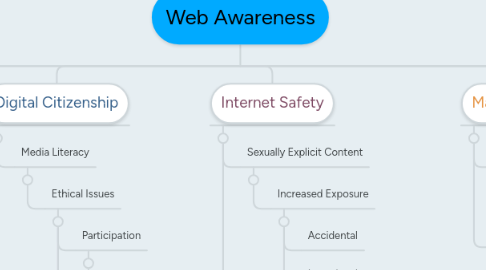
1. Digital Citizenship
1.1. Media Literacy
1.1.1. Ethical Issues
1.1.1.1. Participation
1.1.1.1.1. Digital Life
1.1.1.2. Identity
1.1.1.3. Privacy
1.1.1.3.1. Digital Footprint
1.1.1.4. Ownership
1.1.1.5. Trustworthiness
1.2. Educate
1.3. Protect
1.4. Respect
1.5. Netiquette
1.5.1. Digital Etiquette
1.5.1.1. Clear Communication
1.5.1.2. Golden Rule
2. Internet Safety
2.1. Sexually Explicit Content
2.1.1. Increased Exposure
2.1.1.1. Accidental
2.1.1.2. Intentional
2.2. CyberBullying
2.2.1. Awareness
2.2.1.1. Preventing
2.2.1.1.1. Education
2.2.1.2. Resolving
2.2.1.3. Eliminating
2.3. Teachers
2.3.1. In Loco Parentis
2.3.1.1. Internet Threat
2.3.1.2. Teach Web Safety
2.3.1.2.1. Classroom Resources
2.3.2. Cyberconduct
2.3.2.1. CyberBullying
2.3.2.2. Social Media
2.3.2.3. Email
2.3.2.4. Rights
2.3.2.5. Responsibilities
3. Authenticity
3.1. Evaluation Criteria
3.1.1. Authority
3.1.2. Coverage
3.1.3. Objectivity
3.1.4. Accuracy
3.1.5. Currency
3.2. Fact vs. Folly
3.3. Email Validity
4. Marketing
4.1. Child Consumers
4.1.1. Youth Target
4.2. Education
5. Privacy
5.1. geotagging
5.2. Online pictures
5.2.1. hackers
5.3. Personal Publishing
5.3.1. Issues
5.3.1.1. Audience
5.3.1.2. Anonymity
5.3.1.3. Permanence
5.3.1.4. Copyright
5.3.1.5. Free Speech
5.4. Vigilance
6. Copyright
6.1. Protection
6.1.1. Intellectual Rights
6.1.1.1. Intellectual Property
6.1.1.1.1. Ownership
6.2. Authorship
6.3. Fair Use
6.4. Creative Commons (CC)
6.4.1. Author rights
6.5. Attribution
6.6. vs. Public Domain
6.7. Teacher role
6.7.1. Leadership
6.7.1.1. Documentation
6.7.1.2. Ethical Use
7. Resource Example
7.1. WebQuests
7.1.1. K-12
7.1.2. Inquiry-oriented
7.1.3. Features
7.1.3.1. Intro.
7.1.3.2. Process
7.1.3.3. Tasks
7.1.3.4. Resources
7.1.3.5. Conclusion
7.1.3.6. Evaluation
